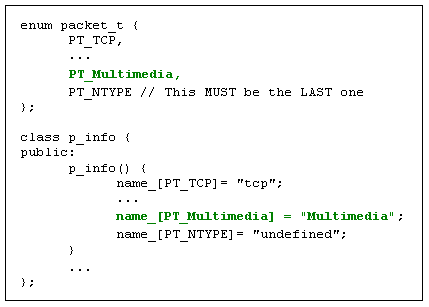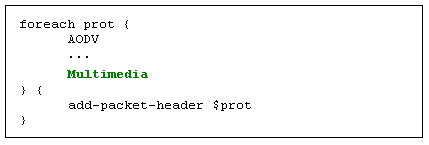Add New Application and Agent
Basically, "five rate media scaling" works as follow. The sender starts with transmission rate associated with scale 0, and changes transmission rates according to the scale value that the receiver notifies. The receiver is responsible for monitoring network congestion and determining the scale factor. For congestion monitoring, a simple periodical (for every RTT second) packet loss monitoring is used, and even a single packet loss for each period is regarded as network congestion. If congestion is detected, the receiver reduces the scale parameter value to half and notifies the sender of this value. If no packet loss is detected, the receiver increases the value by one and notifies the sender.
- MmApp Header: For the application level communication, we decided to define a header of which the structure named in C++ "hdr_mm". Whenever the application has information to transmit, it will hand it to "UdpMmAgent" in the "hdr_mm" structure format. Then, "UdpMmAgent" allocates one or more packets (depending on the simulated data packet size) and writes the data to the multimedia header of each packet. Figure 23 shows the header definition, in which a structure for the header and a header class object, "MultimediaHeaderClass" that should be derived from "PacketHeaderCalss" is defined. In defining this class, the OTcl name for the header ("PacketHeader/Multimedia") and the size of the header structure defined are presented. Notice that bind_offset() must be called in the constructor of this class.

Figure 23. MM Header Structure & Class (in "udp-mm.h" & "udp-mm.cc")
Figure 24 (a). Add to the "packet.h" file (C++)We also add lines to packet.h and ns-packet.tcl as shown in Figure 24 (a) and (b) to add our "Mulltimedia" header to the header stack. At this point, the header creation process is finished, and "UdpMmAgent" will access the new header via hdr_mm::access() member function. Please refer to NS Manual for detailed information on header creation and access methods. For the rest of the application and the modified UDP agent description, refer directly to "mm-app.h", "mm-app.cc", "udp-mm.h" and "udp-mm.cc" files as needed.
Figure 24 (b). Add to the "ns-packet.tcl" file (Otcl)
- MmApp Sender: The sender uses a timer for scheduling the next application data packet transmission. We defined the "SendTimer" class derived from the "TimerHandler" class, and wrote its "expire()" member function to call "send_mm_pkt()" member function of the "MmApp" object. Then, we included an instance of this object as a private member of "MmApp" object referred to as "snd_timer_". Figure 25 shows the "SendTimer" implementation.Before setting this timer, "MmApp" re-calculates the next transmission time using the transmission rate associated with the current scale value and the size of application data packet that is given in the input simulation script (or use the default size). The "MmApp" sender, when an ACK application packet arrives from the receiver side, updates the scale parameter.

Figure 25. SendTimer Implementation.
- MmApp Receiver: The receiver uses a timer, named "ack_timer_", to schedule the next application ACK packet transmission of which the interval is equal to the mean RTT. When receiving an application data packet from the sender, the receiver counts the number of received packets and also counts the number of lost packets using the packet sequence number. When the "ack_timer_" expires, it invokes the "send_ack_pkt" member function of "MmApp", which adjusts the scale value looking at the received and lost packet accounting information, resets the received and lost count to 0, and sends an ACK packet with the adjusted scale value. Note that the receiver doesn't have any connection establishment or closing methods. Therefore, starting from the first packet arrival, the receiver periodically sends ACK packets and never stops (this is a bug).
- UdpMmAgent: The "UdpMmAgent" is modified from the "UdpAgent" to have the following additional features: (1) writing to the sending data packet MM header the information received from a "MmApp" (or reading information from the received data packet MM header and handing it to the "MmApp"), (2) segmentation and re-assembly ("UdpAgent" only implements segmentation), and (3) setting the priority bit (IPv6) to 15 (max priority) for the "MmApp" packets.
- Modify "agent.h": To make the new application and agent running with your NS distribution, you should add two methods to "Agent" class as public. In the "command" member function of the "MmApp" class, there defined an "attach-agent" OTcl command. When this command is received from OTcl, "MmApp" tries to attach itself to the underlying agent. Before the attachment, it invokes the "supportMM()" member function of the underlying agent to check if the underlying agent support for multimedia transmission (i.e. can it carry data from application to application), and invokes "enableMM()" if it does. Even though these two member functions are defined in the "UdpMmAgnet" class, it is not defined in its base ancestor "Agent" class, and the two member functions of the general "Agent" class are called. Therefore, when trying to compile the code, it will give an error message. Inserting the two methods as public member functions of the "Agent" class (in "agent.h") as follows will solve this problem.

Figure 26 (a). Add two member functions to "Agent" class. - Modify "app.h": You also need to add an additional member function "recv_msg(int nbytes, const char *msg)" to "Application" class as shown in Figure 26 (b). This member function, which was included in the "Application" class in the old versions of NS (ns-2.1b4a for sure), is removed from the class in the latest versions (ns-2.1b8a for sure). Our multimedia application was initially written for the ns-2.1.b4a, and therefore requires "Application::recv_msg()" member function for ns-2.1b8a or later versions.

Figure 26 (b). Add a member function to "Application" class. - Set default values for new parameter in the "ns-default.tcl": After implementing all the parts of the application and agent, the last thing to do is to set default values for the newly introduced configurable parameters in the "ns-default.tcl" file. Figure 26 shows an example of setting the default values for configurable parameters introduced by "MmApp".

Figure 27. Default parameter value settings
- Download "mm-app.h", "mm-app.cc", "udp-mm.h" and "udp-mm.cc") to the "ns-2" directory.
- Make sure you registered the new application header by modifying "packet.h" and "ns-packet.tcl" as shown in Figure 24 (a) and (b).
- Add supportMM() and enableMM() methods to the "Agent" class in "agent.h" as shown in Figure 26 (a).
- Add recv_msg() method to the "Application" class in "app.h" as shown in Figure 26 (b).
- Set default values for the newly introduced configurable parameters in "ns-default.tcl" as described in Figure 27. Be SURE to complete this last step. Otherwise, all five-scale rates are initialized to zero unless specified in the input simulation script (i.e., the test simulation script given below will not transmit any frames).
After you've done all things in the checklist, modify your "Makefile" as needed (include "mm-app.o" and "udp-mm.o" in the object file list) and re-compile your NS. Be SURE to run "make clean" and "make depend" before you re-compile your modified NS, otherwise the new application may not transmit any packets. It is generally a good practice to do "make depend" after you make changes in "Makefile" before a re-compile.

Figure 28. Test Simulation Topology and Scenario

No comments:
Post a Comment